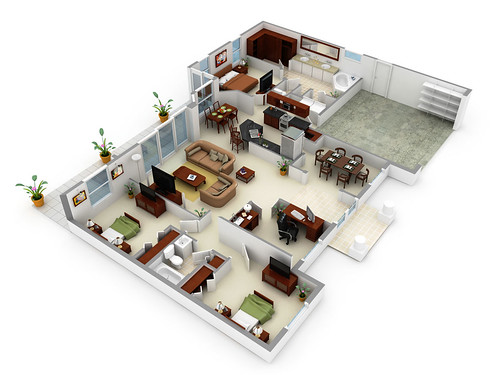
As an architectural visualization artist we have to always try to create photo real images to represent our projects, and to full fill the expectations of our clients. If you use Blender 3D for your architectural visualization projects, you may already asked yourself which one is the best external render for architectural visualization in Blender? This is a common question for beginners or artists with less experience. Last week I saw an article at BlenderNation, pointing out a study made by an artist called Abhishek Gupta with the comparison between renders like LuxRender, Kerkythea, YafaRay and the Blender internal render.
For architectural visualization projects, especially if you are going to use Blender 3D as the modeler environment I recommend you to use not only one, but put a set of at least two render engines to use for your projects. With LuxRender and YafaRay we can set a powerful production environment that fits almost any requirements of simple and complex projects.
The reason to choose two render engines is quite simple, and it`s related with the way both renders works. With LuxRender we have an unbiased render engine that simulates physical light behavior, with leads to incredible and realistic images. If you have ever used an Unbiased render engine, you probably know that with a minimum setup of lights we can achieve great looking renders. The cost of this level of quality is the render time, which can be very long with those renders.
With YafaRay we have biased methods to render images, using tricks and techniques to simulate the way light works in the real world. We can also achieve great quality images, but the amount of setup required is a bit bigger than with LuxRender. One of the great things about YafaRay is the render speed! With YafaRay we have the best balance between render time and image quality.
For my projects I always choose YafaRay for external render scenes, which gives me the best in quality and speed. At interior scenes, every time I have the time to spend on rendering I choose LuxRender. But, when the client needs an image with a short deadline I use YafaRay.
The bottom line is that you have to take in consideration the amount of time available to finish the project, and choose the best render engine for each context. Both of them have ups and downs, but are undoubtedly great render engines for architectural visualization in Blender 3D.







Allan, I’d love to see you write an article setting up Yafaray for an exterior project. Also, I’d like to see Luxrender setup for an interior scene with no sunlight, i.e. a jail, or manufacturing building.
Thanks,
Zack
Thank you for the post (and since this is my first comment, also for the website).
I’m a student of architecture who is moving his firsts steps in the 3d modelling world, so I’m always looking for suggestions and tips. Now I think I found some good points to start with.
I dont’ understand Luxrender well, that’s why I use Yafaray more, but I really want to use both, because you can have a great balance. This webpage is very interesting, it’s very nice to see that poeploe use Blender for this kind of stuff. Congratulations!!
We’re actually starting our architecture bussiness (my dad’s an architect), and this page has taught me a lot, continue like this!!!
YafaRay, despite being fast and powerful lacks camera clipping. It is not critical, but sometimes very inconvenient in interior scenes.
The example shown in this post is really awesome. I’d love you could make a detailed tutorial from modeling to rendering. It would be so useful for everyone using Blender 3D (and in may case: Yafaray).
too bad that the render you’ve posted is made in 3ds max and vray 🙂
🙂 as soon as possible!